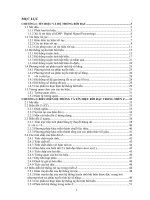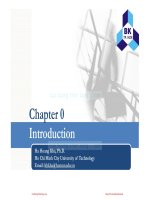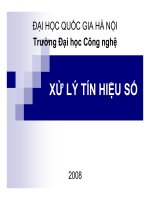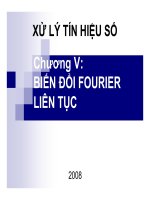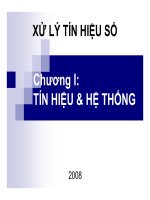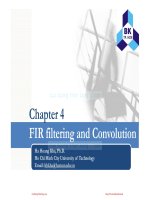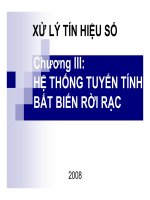Bài giảng Xử lý tín hiệu số: Chapter 0 - Hà Hoàng Kha
Bạn đang xem bản rút gọn của tài liệu. Xem và tải ngay bản đầy đủ của tài liệu tại đây (738.54 KB, 18 trang )
Chapter
p 0
Introduction
Ha Hoang Kha, Ph.D.Click to edit Master subtitle style
Ho Chi Minh City University of Technology
@
Email:
CuuDuongThanCong.com
/>
1. Signal and Systems
A signal is defined as any physical quantity that varies with time,
space or an
space,
any other independent variables.
ariables
Speech, image, video and electrocardiogram signals are information-bearing
signals.
g
Mathematically, we describe a signal as a function of one or more
independent
p
variables.
Examples:
x(t ) = 110sin(2π ⋅ 50t )
I ( x, y ) = 3 x + 2 xy + 10 y 2
A system is defined as a physical device that performs any operation
g
on a signal.
A filter is used to reduce noise and interference corrupting a desired
information-bearing signal.
Ha H. Kha
2
CuuDuongThanCong.com
Introduction
/>
1. Signal and Systems
Signal processing is to pass a signal
through
h
h a system.
A digital system can be
implemented as a digital computer
or digital hardware (logic circuits).
Ha H. Kha
3
CuuDuongThanCong.com
Introduction
/>
2. Classification of Signal
Multichannels and Multidimensional signals
Signals which are generated by multiple sources or multiple sensors
can be represented in a vector form. Such a vector of signals is
referred to as a multichannel
m ltichannel signals
Ex: 3-lead and 12-lead electrocardiograms (ECG) are often used in practice,
which results in 33-channel
channel and 12-channel
12 channel signals
signals.
A signal is called M-dimensional if its value is a function of M
independent
d
d variable
b
Picture: the intensity or brightness I(x,y) at each point is a function of 2
independent variables
Color TV picture is 3-dimensional signals I(x,y,t)
Ha H. Kha
4
CuuDuongThanCong.com
Introduction
/>
2. Classification of Signal
Continous-time versus discrete-time signal
Signals can be classified into four different categories depending on
the characteristics of the time variable and the values they take.
Time
Continuous
Discrete
Amplitue
x(n)
( )
(t)
x(t)
Continuous
t
n
Analog signal
xQ(t)
Discrete
t
Quantized signal
Ha H. Kha
Discrete time signal
111 xQ(n)
110
101
100
011
n
010
001
000
Digital signal
Digital signal
5
CuuDuongThanCong.com
Introduction
/>
3. Basic elements of a DSP system
Most of the signals encountered in science and engineering are
analog in nat
nature.
re To perform the processing digitall
digitally, there is a need
for an interface between the analog signal and the digital processor
Fig: Analog signal processing
Fi Digital
Fig:
Di i l signal
i l processing
i
Ha H. Kha
6
CuuDuongThanCong.com
Introduction
/>
4. DSP applications-Communications
Telephony: transmission of information in
digital form via telephone lines, modem
technology, mobile phone.
Encoding and decoding of the
information sent over physical
channels
h nn l (t
(to optimize
ptimiz
transmission, to detect or
correct
co
ect errors
e o s in transmission)
t a s ss o )
Ha H. Kha
7
CuuDuongThanCong.com
Introduction
/>
4. DSP applications-Radar
Radar and sonar:
Target detection:
position and
velocity estimation
Tracking
Ha H. Kha
8
CuuDuongThanCong.com
Introduction
/>
4. DSP applications-Biomedical
Analysis of biomedical signals, diagnosis, patient monotoring,
pre enti e health care,
preventive
care artificial organs
organs.
Examples:
Electrocardiogram
l
di
(ECG)
( CG) signal
i l provides
id
information about the condition of the
patient’ss heart.
patient
heart
Electroencephhalogram (EEG) signal
pro ides information abo
provides
aboutt the
activity of the brain.
Ha H. Kha
9
CuuDuongThanCong.com
Introduction
/>
4. DSP applications-Speech
Noise reduction: reducing
backgro nd noise in the sequence
background
seq ence
produced by a sensing device (a
microphone).
p
)
Speech recognition: differentiating
between various speech sounds
Synthesis of artificial speech :
text to speech systems
Ha H. Kha
10
CuuDuongThanCong.com
Introduction
/>
4. DSP applications-Image Processing
Content based image retrievalbro sing searching and retrie
browsing,
retrieving
ing
images from database.
Image enhancement
Compression: reducing the
g data to
redundancyy in the image
optimize transmission/storage
Ha H. Kha
11
CuuDuongThanCong.com
Introduction
/>
4. DSP applications-Multimedia
Generation storage and transmission
of sound,
so nd still images
images, motion
pictures.
Digital TV
Video conference
Ha H. Kha
12
CuuDuongThanCong.com
Introduction
/>
The Journey
“ Learning
L
i digital
di i l signal
i l processing
i is
i not something
hi
you accomplish; it’s a journey you take”.
R.G. Lyons, Understanding Digital Signal Processing
Ha H. Kha
13
CuuDuongThanCong.com
Introduction
/>
5. Advantages of digital
over analog signal processing
A digital programmable system allows flexibility in reconfiguring the
DSP operations simply by changing the program.
A digital system provides much better control of accuracy
requirements.
Digital
g signals
g
are easilyy stored.
DSP methods allow for implementation of more sophisticated signal
processingg algorithms.
p
g
Limitation:
Li it ti Practical
P ti l limitations
li it ti
off DSP are the
th quantization
ti ti errors
and the speed of A/D converters and digital signal processors -> not
suitable for analog signals with large bandwidths.
Ha H. Kha
14
CuuDuongThanCong.com
Introduction
/>
Course overview
Introduction to Digital Signal Processing (3 periods)
Sampling and reconstruction, quantization (6 periods)
Analysis of linear time invariant systems (LTI)(3 periods)
Finite Impulse Response (FIR) of LTI systems (3 periods)
Z-transform and its applications to the analysis of linear systems (6
periods)
Mid-term Exam
Fourier transform & FFT Algorithm (9 periods)
Digital filter realization(3 periods)
FIR and IIR filter designs (9 periods)
Final Exam
Ha H. Kha
15
CuuDuongThanCong.com
Introduction
/>
References
Text
T t books:
b k
[1] S. J. Orfanidis, Introduction to Signal Processing, Prentice –Hall
Publisher 2010.
Publisher 2010.
[2] J. Proakis, D. Manolakis, Introduction to Digital Signal
Processing, Macmillan Publishing Company, 1989.
Reference books:
[3] V K Ingle J Proakis Digital Signal Processing Using Matlab
[3] V. K. Ingle, J. Proakis, Digital Signal Processing Using Matlab,
Cengage Learning, 3 Edt, 2011.
Ha H. Kha
16
CuuDuongThanCong.com
Introduction
/>
Learning outcomes
Understand how to convert the analog to digital signal
Have
Have a thorough grasp of signal processing in linear time‐invariant
a thorough grasp of signal processing in linear time invariant
systems.
Understand the z‐transform and Fourier transforms in analyzing
the signal and systems
the signal and systems.
Be able to design and implement FIR and IIR filters.
Ha H. Kha
17
CuuDuongThanCong.com
Introduction
/>
Assessment
Mid‐term exam: 30%
Final exam: 70%
Bonus: 0.5 mark/solving a problem in the class.
Ha H. Kha
18
CuuDuongThanCong.com
Introduction
/>

